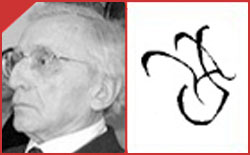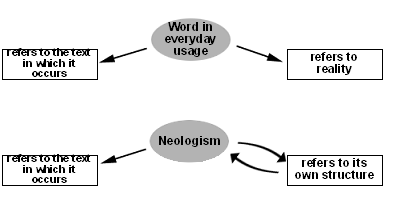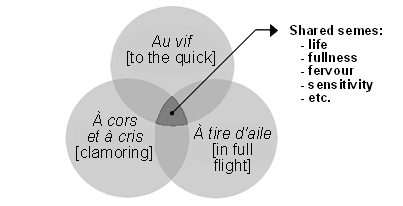Available Languages
- Consultez cette page en FRANÇAIS
- Consult this page in ENGLISH
Poetic Language
By Johanne Prud’homme and Nelson Guilbert
Université du Québec à Trois-Rivières
1. ABSTRACT
Riffaterre

According to Michael Riffaterre, a poem does not signify in the same way as a prose text. When poetry is analyzed, often "words are judged in relation to things, and the text is judged in comparison to reality" (Riffaterre, 1983, 26). In order to avoid this, we must understand what distinguishes poetic language from the language of prose: A poem establishes a system of significance, generated by processes such as accumulation and the use of descriptive systems. Poetic language is also set apart from prose by the special status of its neologisms.
This text may be reproduced for non-commercial purposes, provided the complete reference is given:
Johanne Prud’homme and Nelson Guilbert (2006), « Poetic Language », in Louis Hébert (dir.), Signo [online], Rimouski (Quebec), http://www.signosemio.com/riffaterre/poetic-language.asp.
2. THEORY
According to Michael Riffaterre, poetic language is different from prosaic language. A poem engenders a system of significance based on processes such as accumulation or the use of descriptive systems. The neologism is a special element of language in the same vein, whose specific features are important to examine.
2.1 HOW DO PROSE AND POETRY SIGNIFY?
Prose is generally interpreted along a vertical axis, also known as the paradigmatic axis or the axis of selection. On this axis, we look for the meaning of the text based on selected referents and terms, following the metaphors and metonymies, or by trying to attribute a coherent meaning to the obscure passages. However, "[...] in the semantics of the poem the axis of significations is horizontal" (Riffaterre, 1983, 35). The poem does not attempt to refer to reality, but to establish a coherent system of significance. A poetic text must therefore be analyzed in terms of the relationships that develop amongst the words along the horizontal axis, also known as the syntagmatic axis or the axis of combination.
2.2 THE HORIZONTAL AXIS OF SIGNIFICATIONS
There are four structures that make up the horizontal axis of significations:
- Linguistic;
- Stylistic;
- Thematic;
- Lexical. (This structure is exclusive to poetry: It involves "similarities in form and position among certain words in the text, similarities that are rationalized and interpreted in terms of meaning" (Riffaterre, 1983, 36)).
Within the lexical structure, there are two categories of formal and positional similarities on which the reader of the poem can reflect:
- One category includes similarities derived by parataxis, which are observable by identifying semantic accumulations.
- In the other category we include similarities involving hypotaxis, which has to do with the co-occurrence of words grouped into descriptive systems.
2.3 ACCUMULATION
Each word is made up of one or more semes (minimal units of meaning, or semantic features). For example, the word "monster" contains the semes: living being, big, ugly, frightening, inhuman, etc. These are the semes in the poem that are used in the process of accumulation.
This process occurs when the reader encounters a series of words that are related through an element of meaning that links them together, that is, a shared seme. As the reader progresses, accumulation "filters through the semantic features of its words, thereby overdetermining the occurrence of the most widely represented seme and cancelling out the semes that appear less frequently" (Riffaterre, 1983, 39). For example, if we encounter the words "rose", "tulip" and "sunflower", then we might think that the shared seme is /flower/; if to this list we add the words "grandiose", "woman" and "art", then the overdetermined seme will be /beauty/.
What's more, the words that are part of the accumulation "become synonyms of one another irrespective of their original meaning in ordinary language" (Riffaterre, 1983, 39). Accumulation does more than just emphasize the overdetermined semes; the semes take the place of the words, and by substituting in this manner, the reader will come within reach of the poem's significance.
2.4 DESCRIPTIVE SYSTEMS
A descriptive system is a constellation of words associated with a concept, or nuclear word (or nucleus): "a nuclear word whose function as such stems from the fact that its signified encompasses and organizes the signifieds of the satellite words" (Riffaterre, 1983, 39). In the following diagram, the nuclear word "king" is surrounded by its satellites.
Diagram of a descriptive system

In other words, a descriptive system is a group of words, expressions and ideas that are used in the text to designate the parts of the whole that the author wants to represent. With accumulation, the relationship between the terms is synonymous, whereas in the case of a descriptive system, "each component of the system functions as a metonym of the nucleus" (Riffaterre, 1978, 39). (Metonymy: naming the part to represent the whole.) This metonymic relationship subordinates all of the words in the descriptive system to the nuclear word, establishing a set of words that are linked together throughout in such a way that if the nucleus is used as a metaphor in the poem, then its descriptive system becomes a metaphor as well.
The descriptive system is usually a set of stereotypes and conventional ideas about the word with which it is associated; this is how the reader realizes, when we make mention of nothing more than white hair, for example, that we are talking about an old person. These systems are located outside the poem; they are part of common sense. Anyone who uses the language has recourse to these systems, and can either conform to them or convert them into unexpected images.
NOTE ON INTERTEXTUALITY
Intertextuality is a phenomenon that is greatly dependent on descriptive systems, for in this case, one text refers to another text, by means of a fragment, a sentence, or even a single word in some cases. If the reader understands the allusion, then he is familiar with the descriptive system involved in the particular intertext, and when he sees the part, he guesses the whole. Intertextual relationships are therefore metonymic by nature.
In their basic construction, all texts seem to have one or more descriptive systems as their foundation, whether the author conforms to them or converts them. A set of clichés and descriptive systems is the starting point, so to speak, in constructing the grammar of the text, and the author produces ungrammaticalities by distorting the clichés and systems.
2.5 THE POETICS OF NEOLOGISMS
Another characteristic that is specific to poetic language is the poetic neologism.
In everyday language, neologisms, or lexical inventions, are essentially used to designate new realities that have not yet received names. However, the literary neologism is an anomaly, and this aspect of verbal creation is precisely what authors are after.
The anomaly is, in fact, an ungrammaticality, the function of literary neologisms being to "condense the dominant characteristics of the text" (Riffaterre, 1983, 74). This function implies that the word is created specifically for the text; but from this standpoint, the primary advantage of neologisms is that they can generally be used to condense the ungrammaticality into a single term. As the following diagram illustrates, this unusual condensation attracts the reader's attention, since poetic neologisms do not refer to reality, as do words in their everyday usage, but rather to their own structure, as well as the structure of the text from which they are derived.
Diagram illustrating the difference between words in everyday usage and literary neologisms

There are two kinds of neological derivation:
- Implicit derivation: This kind of neologism distorts or condenses terms that are outside the text, but present in the mind of the reader. (The term from outside the text might originate from a cliché or a descriptive system familiar to the reader, for example.)<
- Explicit derivation: This kind of neologism is created from terms already present in the text.
Explicit derivation can function in two different ways:
- The neologism can be derived synonymously from a group of words that overdetermines a specific seme.
- The neologism can be created by opposition with another term with which it maintains a dialectic relationship (for example, in Victor Hugo: "les extorqués faisant cortège aux extorqueurs" ["the extortionees dancing attendance on the extortioners"].
NOTE: NEOLOGISMS AND SEMANTIC CONDENSATION
The neologism does not constitute a subcategory within lexical structure (the similarities in form and position among certain words in the text), but it does represent an element that is particularly useful when we are looking for hypotactic or paratactic similarities, as a neologism can condense several semes or descriptive systems within itself and link them together.
In order to analyze a neologism within the context of the poem, we must first observe its relationships to the structure of the rest of the poem (the accumulations and descriptive systems), and if applicable, attempt to understand the relationship between this term and the term from which it was created. Since the neologism is, practically speaking, a stylistic unit condensed into a single term, it is undeniably the purest form found in poetic language.
3. APPLICATION
According to Michael Riffaterre, poetic language derives from two principles, which we will now illustrate.
3.1 AN EXAMPLE OF ACCUMULATION
Accumulation is manifested when it becomes possible to establish a relationship within a series of words. The relationship may be established by identifying an element of meaning that links them together, that is, a shared seme. The following diagram shows an example of several shared semes resulting from the overlap between three familiar expressions.
Diagram of accumulation by parataxis

3.2 AN EXAMPLE OF A DESCRIPTIVE SYSTEM
Whereas the principle of accumulation is based on synonymy, descriptive systems are based on metonymy. For example, what is the nucleus upon which the following words are centred: "branch", "bark", "roots", "logger", the idea of durability and the cliché "a cloak of leaves to be shed when autumn comes"? These words, scattered throughout the text, are the elements clustered around the "nuclear word", which will not necessarily even appear in the text. In the case we are considering, we can see that the descriptive system is undoubtedly determined by a nucleus we identify as "tree".
4. LIST OF WORKS CITED
- RIFFATERRE, M., Text Production, New York: Columbia University Press, 1983.
- RIFFATERRE, M., Semiotics of Poetry, Bloomington: Indiana University Press, 1978.
5. EXERCISES
[…]
Le soleil brille pour tout le monde, il ne brille pas dans les prisons, il ne brille pas pour ceux qui travaillent dans la mine
ceux qui écaillent le poisson
ceux qui mangent de la mauvaise viande
ceux qui fabriquent les épingles à cheveux
ceux qui soufflent vides les bouteilles que d’autres boiront pleines
ceux qui coupent le pain avec leur couteau
ceux qui passent leurs vacances dans les usines
ceux qui ne savent pas ce qu‘il faut dire
ceux qui traient les vaches et ne boivent pas le lait
[…]
ceux qui en ont trop à dire pour pouvoir le dire
ceux qui ont du travail
ceux qui n’en ont pas
ceux qui en cherchent
ceux qui n’en cherchent pas
[…]
[…]
The sun shines for everyone, it doesn’t shine in the prisons, it doesn’t shine for those who work in the mines
those who scale fish
those who eat rotten meat
those who manufacture hairpins
those who blow the empty bottles that others will drink from full
those who cut bread with their knives
those who spend their vacations in the factories
those who don’t know what to say
those who milk the cows and don’t drink the milk
[…]
those who have too much to say to be able to say it
those who have work
those who have none
those who seek it
those who do not
[…]
In this enumeration, try to find which seme(s) are overdetermined through accumulation.
B. Consider the following poem by Jacques Prévert (Paroles, Paris: Gallimard, 2000 [1949], p. 205):
L’automne
Un cheval s’écroule au milieu d’une allée
Les feuilles tombent sur lui
Notre amour frissonne
Et le soleil aussi
Autumn
A horse collapses in the middle of an alley
Leaves fall on him
Our love trembles
And the sun too.

